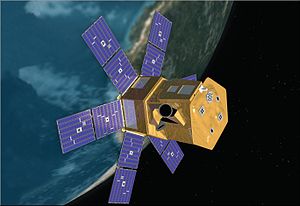Solar Radiation and Climate Experiment
 SORCE in flight | |
| Organization | NASA, LASP at CU-Boulder |
|---|---|
| Contractor | Orbital Sciences Corporation |
| Mission Type | Astrophysics |
| Satellite of | Earth |
| Launch | January 25, 2003 on a Pegasus XL |
| Launch site | Cape Canaveral |
| Mission duration | 6 years |
| Mass | 315 kg (launch), 290 kg (dry) |
| Webpage | http://lasp.colorado.edu/sorce/ |
| Orbital elements | |
| Semimajor Axis | 7002.26 km |
| Eccentricity | .0024 |
| Inclination | 39.99 degrees |
| Orbital Period | 97.19 minutes |
| Right ascension of the ascending node | 135.41 degrees |
| Argument of perigee | 136.06 degrees |
| Instruments | |
| TIM | Total Irradiance Monitor |
| SOLSTICE | Solar Stellar Irradiance Comparison Experiment |
| SIM | Spectral Irradiance Monitor |
| XPS | XUV Photometer System |
The Solar Radiation and Climate Experiment (SORCE) is a NASA-sponsored satellite mission that provides state-of-the-art measurements of incoming X-ray, ultraviolet, visible, near-infrared, and total solar radiation. The measurements provided by SORCE specifically address long-term climate change, natural variability and enhanced climate prediction, and atmospheric ozone and UV-B radiation. These measurements are critical to studies of the Sun; its effect on our Earth system; and its influence on humankind.
SORCE measures the Sun's output with the use of state-of-the-art radiometers, spectrometers, photodiodes, detectors, and bolometers engineered into instruments mounted on a satellite observatory. The SORCE satellite orbits around the Earth accumulating solar data. Spectral measurements identify the irradiance of the Sun by characterizing the Sun's energy and emissions in the form of color that can then be translated into quantities and elements of matter. Data obtained by the SORCE experiment can be used to model the Sun's output and to explain and predict the effect of the Sun's radiation on the Earth's atmosphere and climate.
The SORCE spacecraft launched on January 25, 2003 on a Pegasus XL launch vehicle to provide NASA's Earth Science Enterprise (ESE) with precise measurements of solar radiation. It launched into a 645-km, 40-degree orbit and is operated by the Laboratory for Atmospheric and Space Physics (LASP) at the University of Colorado at Boulder, Colorado, USA. It will continue the precise measurements of total solar irradiance that began with the ERB instrument in 1979 and has continued to the present with the ACRIM series of measurements. SORCE will also provide the measurements of the solar spectral irradiance from 1 nm to 2000 nm, accounting for 95% of the spectral contribution to the total solar irradiance. SORCE carries four instruments including the Total Irradiance Monitor (TIM), Solar Stellar Irradiance Comparison Experiment (SOLSTICE), Spectral Irradiance Monitor (SIM), and the XUV Photometer System (XPS).
See also
Template:Space-based meteorological observation
